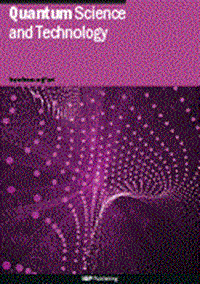从指数到二次:受挫伊辛环模型的最优控制
IF 5
2区 物理与天体物理
Q1 PHYSICS, MULTIDISCIPLINARY
引用次数: 0
摘要
基于两个哈密顿量(一个简单的驱动项和待解的复杂问题)之间的插值,在时间上具有线性调度的传统量子退火(QA)中,指数级小的谱隙被认为是关键瓶颈。具有指数级小谱隙的最简单模型之一是具有单个反铁磁键的铁磁伊辛环。该模型之前的研究已经探索了连续时间非绝热QA,其中优化的非绝热退火计划提供了很好的解决方案,避免了指数级大的退火时间。在我们的工作中,我们转向了变分量子算法的数字框架,并提出了两个主要结果:(1)我们表明该模型是数字可控的,其资源的缩放随系统大小呈二次增长,使用量子近似优化算法实现精确解;(2)我们将量子控制技术——切碎随机基方法——与数字化量子退火技术相结合,构建光滑的数字时序,得到精度很高的最优解。本文章由计算机程序翻译,如有差异,请以英文原文为准。
From exponential to quadratic: optimal control for a frustrated Ising ring model
Exponentially small spectral gaps are known to be the crucial bottleneck for traditional Quantum Annealing (QA) based on interpolating between two Hamiltonians, a simple driving term and the complex problem to be solved, with a linear schedule in time. One of the simplest models exhibiting exponentially small spectral gaps is a ferromagnetic Ising ring with a single antiferromagnetic bond introducing frustration. Previous studies of this model have explored continuous-time diabatic QA, where optimized non-adiabatic annealing schedules provided good solutions, avoiding exponentially large annealing times. In our work, we move to a digital framework of Variational Quantum Algorithms, and present two main results: (1) we show that the model is digitally controllable with a scaling of resources that grows quadratically with the system size, achieving the exact solution using the Quantum Approximate Optimization Algorithm; (2) We combine a technique of quantum control—the Chopped RAndom Basis method—and digitized quantum annealing to construct smooth digital schedules yielding optimal solutions with very high accuracy.
求助全文
通过发布文献求助,成功后即可免费获取论文全文。
去求助
来源期刊

Quantum Science and Technology
Materials Science-Materials Science (miscellaneous)
CiteScore
11.20
自引率
3.00%
发文量
133
期刊介绍:
Driven by advances in technology and experimental capability, the last decade has seen the emergence of quantum technology: a new praxis for controlling the quantum world. It is now possible to engineer complex, multi-component systems that merge the once distinct fields of quantum optics and condensed matter physics.
Quantum Science and Technology is a new multidisciplinary, electronic-only journal, devoted to publishing research of the highest quality and impact covering theoretical and experimental advances in the fundamental science and application of all quantum-enabled technologies.
 求助内容:
求助内容: 应助结果提醒方式:
应助结果提醒方式:


